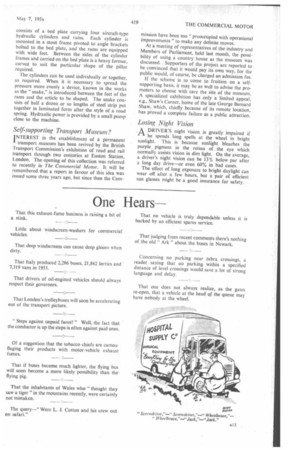Passing Comments
Page 38

Page 39

If you've noticed an error in this article please click here to report it so we can fix it.
Red Rag to a Reporter
THE U.S.S.R.'s touchiness is not confined to inter' national politics. There was evidence of it at the Milan Fair, where P. A. C. Brockington, of The Commercial Motor, fell foul of the Italian police, who were summoned by the Russians when he was photographing an M.A.S. 25-ton tipping lorry.
Mr. Brockington was prevented by the police from taking further pictures of the many Russian vehicles displayed, which included four-wheeled lorries, a track-laying tractor, a tower wagon, a fire-engine and a scraper. He was later informed by the Fair authorities that photographs could be taken in any part of the exhibition.
One of the vehicles was a B.A.S. 2i-ton fourwheeler with a gross laden weight of 6 tons. It has a six-cylindered oil engine developing 70 b.h.p. at 2,800 r.p.m. and a rated fuel consumption equal to 14 m.p.g. Tyres of 7.50 in. by 20 in. section are fitted.
It is understood that Russian manufacturers applied for space for commercial vehicles and cars at the B12 Turin Motor Show, but they were dissatisfied with the positions offered and space allocated.
Somebody ought to tell the Russians that the M.A.S. tipper was described and illustrated in The Commercial Motor on October 17, 1952.
Aircraft "Jacks" Shape Body Pillars
nURING a recent visit to the works of Saunders Roe (Anglesey), Ltd., where these specialists in lightweight coach and bus construction produce bodies such as the Sara for many important operators, a representative of The Commercial Motor was particularly interested in the tool and press equipment designed for the speedy and accurate production of the assemblies from which the complete bodies are built.
Some of this equipment has been designed and constructed in the factory. One of the most novel is a hydraulic bending machine which, in one operation, shapes the body pillars to the contour required. It consists of a bed plate carrying four aircraft-type hydraulic cylinders and rams. Each cylinder is mounted in a stout frame pivoted to angle brackets bolted to the bed plate, and the rams are equipped with wide feet. Between the sides of the cylinder frames and carried on the bed plate is a heavy former, curved to suit the particular shape of the pillar required.
The cylinders can be used individually or together, as required. When it is necessary to spread the pressure more evenly a device, known in the works as the "snake," is introduced between the feet of the rams and the article to be shaped. The snake consists of half a dozen or so lengths of steel strip put together in laminated form after the style of a road spring. Hydraulic power is provided by a small pump close to the machine.
Self-supporting Transport Museum?
INTEREST in the establishment of a permanent I transport museum has been revived by the British Transport Commission's exhibition of road and rail transport through two centuries at Euston Station, London. The opening of this collection was referred to recently in The Commercial Motor. It will be remembered that a report in favour of this idea was issued some three years ago, but since then the Corn
mission have been too "preoccupied with operational improvements" to make any definite moves.
At a meeting of representatives of the industry and Members of Parliament, held last month, the possibility of using a country house as the museum was discussed_ . Supporters of the project are reported to be convinced that it would pay its own way, for the public would, of course, be charged an admission fee.
If the scheme is to come to fruition on a selfsupporting basis, it may be as well to advise the promoters to choose with care the site of the museum. A specialized exhibition has only a limited appeal, e.g., Shaw's Corner, home of the late George Bernard Shaw, which, chiefly because of its remote location, has proved a complete failure as a public attraction.
Losing Night Vision
A DRIVER'S night vision is greatly impaired if Am he spends long spells at the wheel in bright sunlight. This is because sunlight bleaches the purple pigment in the retina of the eye which normally assists vision in dim light. On the average, a driver's night vision can be 13% below par after a long day drive—or even 60% in bad cases.
The effect of long exposure to bright daylight can wear off after a few hours, but a pair of efficient sun glasses might be a good insurance for safety.








































































































